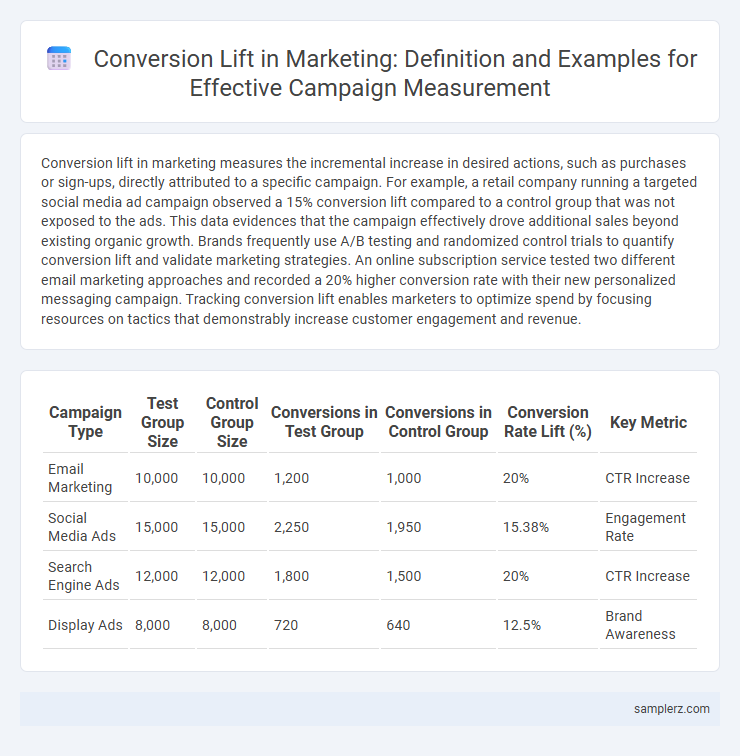Conversion lift in marketing measures the incremental increase in desired actions, such as purchases or sign-ups, directly attributed to a specific campaign. For example, a retail company running a targeted social media ad campaign observed a 15% conversion lift compared to a control group that was not exposed to the ads. This data evidences that the campaign effectively drove additional sales beyond existing organic growth. Brands frequently use A/B testing and randomized control trials to quantify conversion lift and validate marketing strategies. An online subscription service tested two different email marketing approaches and recorded a 20% higher conversion rate with their new personalized messaging campaign. Tracking conversion lift enables marketers to optimize spend by focusing resources on tactics that demonstrably increase customer engagement and revenue.
Table of Comparison
| Campaign Type | Test Group Size | Control Group Size | Conversions in Test Group | Conversions in Control Group | Conversion Rate Lift (%) | Key Metric |
|---|---|---|---|---|---|---|
| Email Marketing | 10,000 | 10,000 | 1,200 | 1,000 | 20% | CTR Increase |
| Social Media Ads | 15,000 | 15,000 | 2,250 | 1,950 | 15.38% | Engagement Rate |
| Search Engine Ads | 12,000 | 12,000 | 1,800 | 1,500 | 20% | CTR Increase |
| Display Ads | 8,000 | 8,000 | 720 | 640 | 12.5% | Brand Awareness |
Defining Conversion Lift in Marketing
Conversion lift in marketing measures the increase in desired customer actions, such as purchases or sign-ups, directly attributed to a specific campaign or advertisement. This metric isolates the campaign's true impact by comparing the behavior of a test group exposed to marketing efforts with a control group that remains unexposed. Marketers use conversion lift analysis to optimize budget allocation and improve return on investment by identifying which campaigns effectively drive incremental conversions.
Importance of Measuring Conversion Lift
Measuring conversion lift is crucial for evaluating the true impact of marketing campaigns on consumer behavior and sales performance. It quantifies incremental sales or actions driven by specific advertising efforts, enabling marketers to optimize budget allocation and improve ROI. Accurate conversion lift analysis informs data-driven decisions, ensuring campaigns effectively influence target audiences and drive measurable business growth.
Conversion Lift vs. Traditional Attribution
Conversion lift measures the incremental impact of marketing campaigns by comparing exposed and control groups, providing a clearer picture of how ads drive actual conversions beyond what traditional attribution models offer. Unlike last-click or multi-touch attribution, which often over- or under-credit specific touchpoints, conversion lift experiments isolate the true causal effect of marketing efforts. Marketers leverage conversion lift to optimize budget allocation by understanding which channels and creatives genuinely increase sales, rather than relying solely on indirect attribution data.
Real-World Example: Social Media Campaign Lift
A social media campaign for a global sportswear brand generated a 25% conversion lift by targeting lookalike audiences on Facebook, measured through a controlled lift test. The experiment revealed that users exposed to the campaign were 40% more likely to complete purchases within 14 days compared to the control group. This data-driven insight helped optimize ad spend and refine targeting strategies for subsequent product launches.
Example: Email Marketing Conversion Lift
Email marketing conversion lift measures the increase in desired actions, such as purchases or sign-ups, directly attributed to targeted email campaigns. By comparing conversion rates between a test group receiving the emails and a control group without exposure, marketers quantify incremental sales or engagement driven by the campaign. This metric helps optimize email content, segmentation, and timing to maximize return on investment and improve overall marketing effectiveness.
Case Study: Ecommerce Conversion Lift Measurement
A leading ecommerce retailer implemented a conversion lift study by dividing audiences into test and control groups, exposing only the test group to targeted digital ads. The results showed a 15% increase in purchase conversions and a 12% boost in average order value among the test group, proving the ads' direct impact on sales. This case study demonstrates how conversion lift measurement accurately quantifies the incremental revenue generated from marketing campaigns.
Conversion Lift from Influencer Marketing Campaigns
Conversion lift from influencer marketing campaigns measures the incremental increase in desired actions, such as purchases or sign-ups, driven by influencer endorsements compared to a control group. Brands analyze metrics like click-through rates, conversion rates, and sales data to quantify the impact of influencer content on customer behavior. This method helps marketers optimize influencer partnerships and allocate budgets toward high-performing creators to maximize return on investment.
Example: Paid Search Conversion Lift Analysis
Paid search conversion lift analysis measures the incremental sales or leads generated by paid search campaigns compared to a control group without exposure to ads. By isolating the impact of paid search ads, marketers can quantify true campaign effectiveness and optimize budget allocation. This approach uses randomized experiments or geo-based testing to attribute lift accurately and improve return on ad spend (ROAS).
Interpreting Conversion Lift Test Results
Interpreting conversion lift test results involves analyzing the incremental impact of marketing campaigns by comparing the conversion rates between test and control groups, isolating the true effect of advertising spend. Conversion lift measures the additional conversions driven directly by the campaign, providing a clear metric to assess ROI and optimize budget allocation. Marketers leverage statistical significance and confidence intervals in test outcomes to make data-driven decisions and refine targeting strategies for improved performance.
Best Practices for Maximizing Conversion Lift
To maximize conversion lift in marketing, use randomized controlled trials (RCTs) to accurately measure the incremental impact of campaigns and avoid attribution errors. Segment audiences based on demographics and behavior for targeted messaging, enhancing relevance and engagement. Continuously analyze data with advanced analytics tools to refine strategies, optimize budget allocation, and improve return on ad spend (ROAS).

example of conversion lift in marketing Infographic
 samplerz.com
samplerz.com